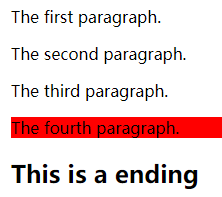代码实现
- last-child / last-of-type
ul li {color: orange;}ul li:last-child {color: unset;}/* 或者 */ul li:last-of-type {color: unset;}
- nth-last-child / nth-last-of-type
ul li {
color: orange;
}
ul li:nth-last-child(n) {
color: unset;
}
/* 或者 */
ul li:nth-last-of-type(n) {
color: unset;
}
- not(以上四种方式)
ul li:not(:last-child) {
color: orange
}
/* 或者 */
ul li:not(nth-last-child(1)) {
color: orange
}
...
last-child 与 last-of-type 的区别
:last-child 选择器用来匹配父元素中最后一个子元素
必须是最后一个子元素,同时必须是指定的元素,否则样式将不生效
<style>
p:last-child {
background:#ff0000;
}
</style>
<body>
<p>The first paragraph.</p>
<p>The second paragraph.</p>
<p>The third paragraph.</p>
<p>The fourth paragraph.</p>

last-of-type 选择器匹配父元素中特定类型的最后一个子元素。
不必是最后一个子元素,只需要是指定的特定类型中的最后一个子元素
<style>
p:last-of-type {
background:#ff0000;
}
</style>
<body>
<p>The first paragraph.</p>
<p>The second paragraph.</p>
<p>The third paragraph.</p>
<p>The fourth paragraph.</p>
<h2>This is a ending</h2>

同样 nth-last-child 和 nth-last-of-type 也是一样的效果
相同的还有 first-child 、 first-of-type 、 nth-child 、 nth-of-type 、 only-of-type 、 only-child
简单理解就是有 type 字段的是先定义元素,再找位置;没有 type 字段的是先定义位置,再找元素

